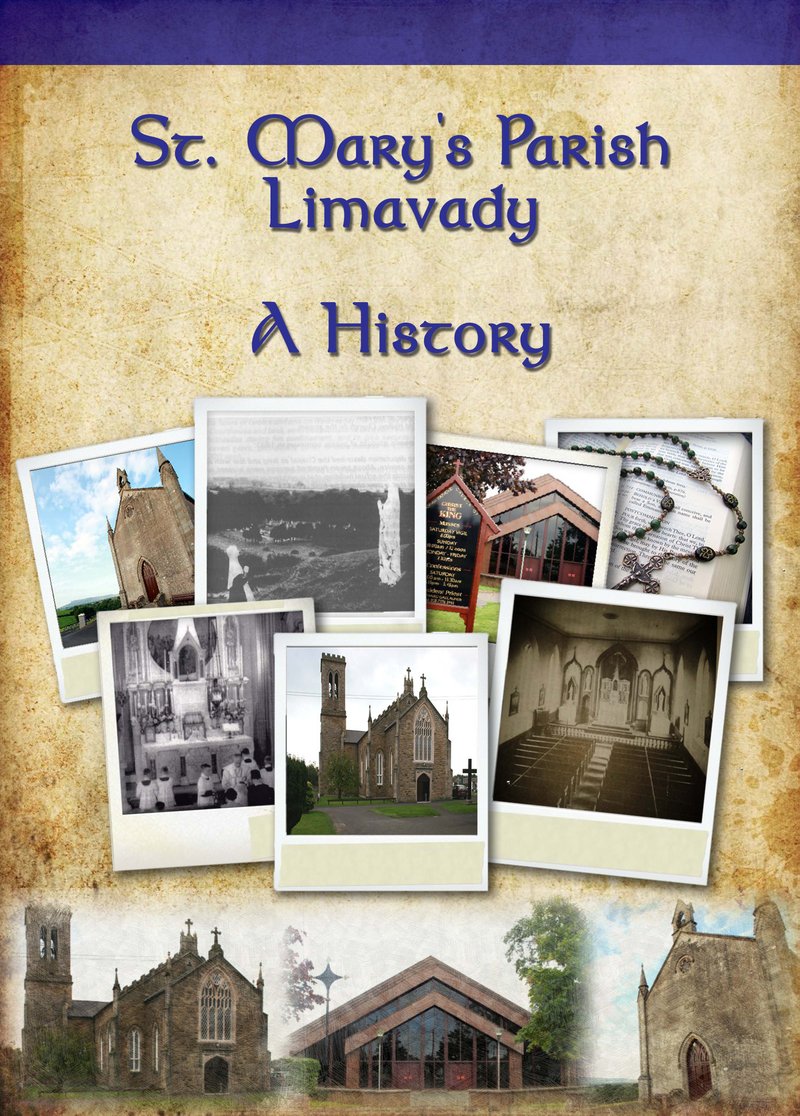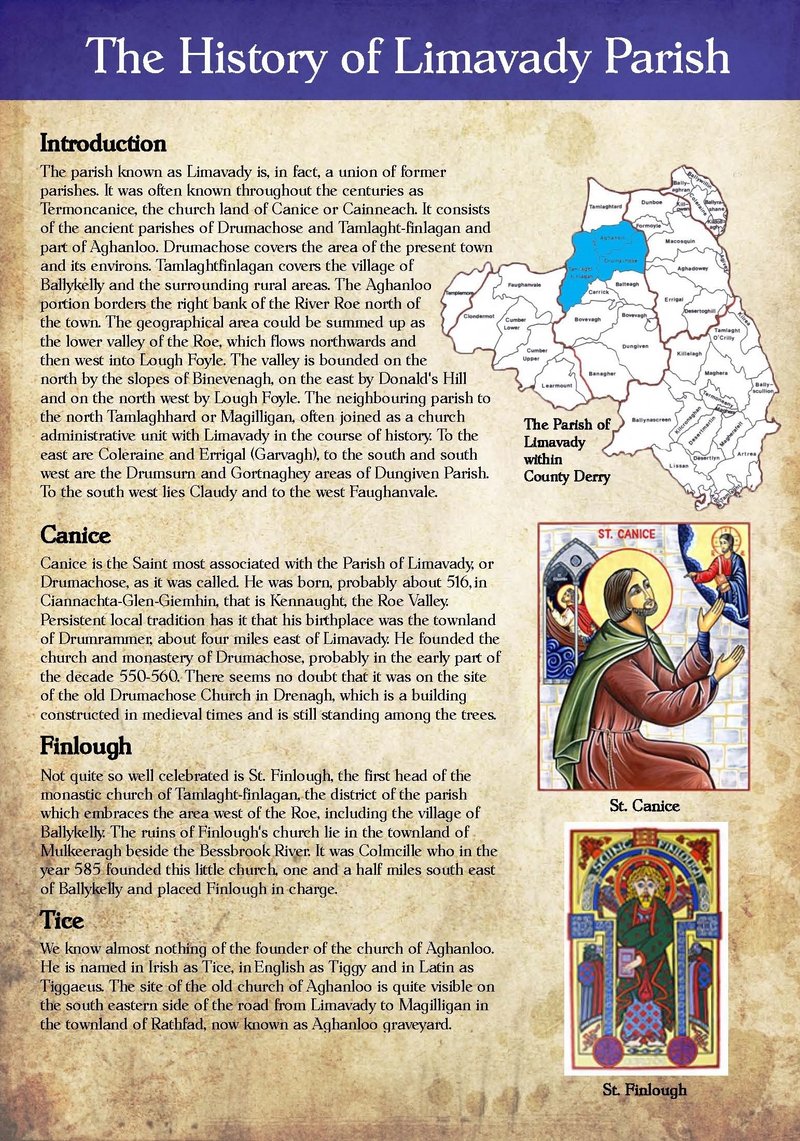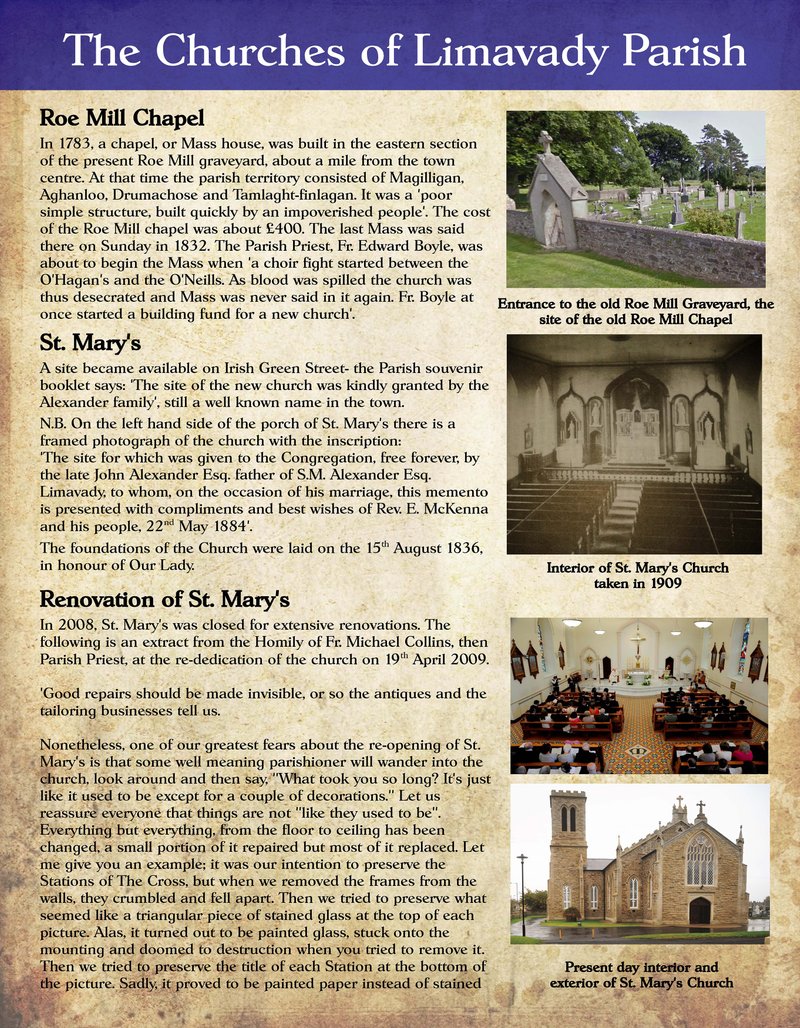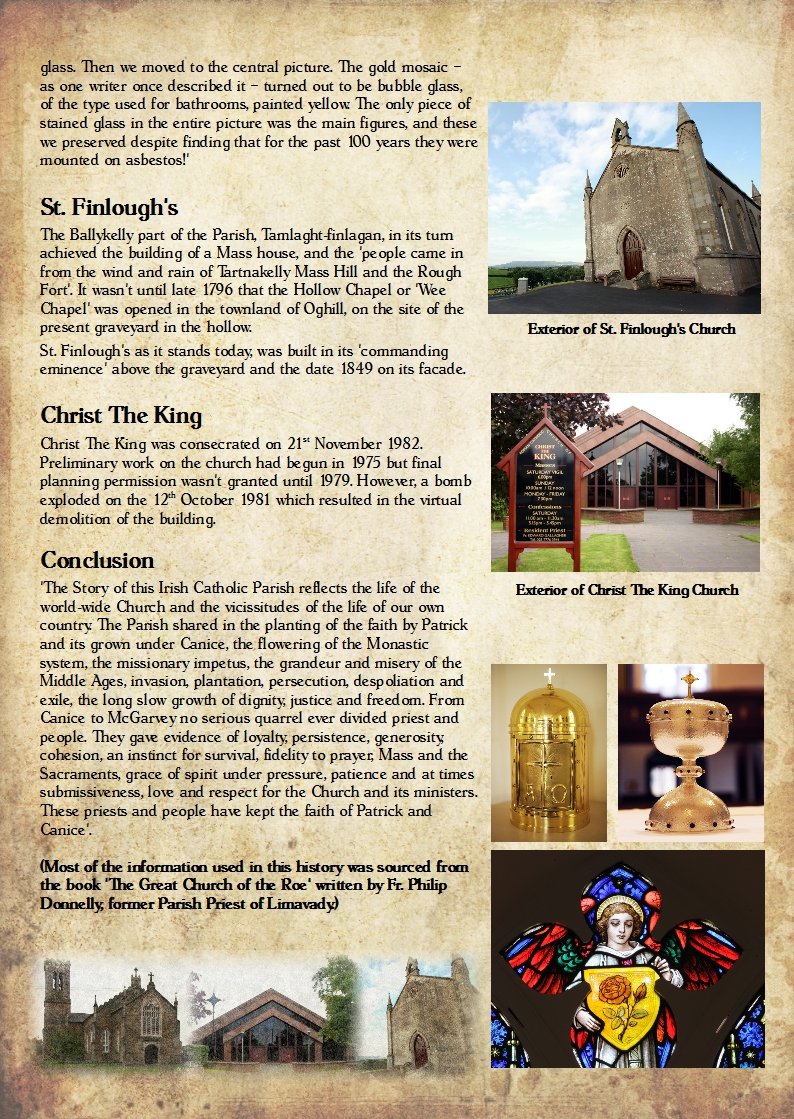Extended History of the Parish of Drumachose, Aghanloo and Tamlaghtfinlagan
There is a tradition that St.Patrick in his missionary journeyings visited this parish. It is more likely that St. Canice (Cainneach), said to have been born in the Drumachose (Limavady) area about 516, founded a monastery here. At Aghanloo there is some record of a church before the eleventh century and its land was administered by an ‘erenagh’ (church steward) until the sixteenth century. There is ground for thinking that Tamlaghtfinlagan (Ballykelly) was the site of a church founded by St. Colmcille for St. Fionnlogha in 585. It had a round tower till comparatively recent times and had erenaghs until the early seventeenth century.
The Convention of Drumceatt took place about the year 590 and was attended by chiefs, bishops and most memorably by Colmcille himself to make decisions on the allegiance of the men of Antrim and on the poets of Ireland. Local tradition has always insisted that the Convention was held on Mullagh Hill on the West Bank of the Roe and that Colmcille reached it by sailing up the Roe from Lough Foyle after the voyage from Iona. The custom in after years was to go there in pilgrimage on All Saints Day.
While the valley of the Roe, called Keenaught (Ciannacht), was under the rule of the O’Conor family in earlier times, the O’Cahans took over the region about the twelfth century, with loose allegiance to the O’Neills.
The rector, or parish priest, of Drumachose always bore the title of ‘coarb’ or successor of Cainneach in Keenaught. We know that he was one Cathasach in the eleventh century and died in 1056, and that John MacThaig (McKeague) was succeeded by Odo MacThaig on the 26th October 1406. A Donald O’Cathain became archdeacon of Derry from 1434 to 1440, and a Maurice O’Cathain was parish priest of Limavady from 1428 to 1458, a long pastorate.
There are records too of the taxes paid by the various churches of the parish, Athlouge (Aghanloo), Tamlaghtinlan and of course Drumachose.
It all came to loss and disaster with the Elizabethan wars, the Plantation and defeat at the hands of Cromwell and William. Owners of land became tenants of their own land, if they were not driven off. The church lands and buildings, so long held, went into the ownership of the established church, later to come into the possession of the McCausland family.
In the sixth century the monastic church of St Canice, from whom the district received the name Termoncanice, stood in Drumachose. The present old church in the Drenagh estate, its successor, was probably built in the thirteenth century. It suffered damage from the cannon of Cromwell and was abandoned by the local Protestants as a place of worship. They still continued to celebrate marriages within its walls, until they built the western part of the present handsome church in Main Street in 1749.
In 1704 Father Donaghey McCloskey lived in Templemoile as parish priest in the parish of Banagher, where it was reasonably safe. He was aged 57 and St. Oliver Plunkett had ordained him in 1670. His securities appear to have been men of another faith, which is a hopeful sign, Edward Bacon of Aghanloo and John Buchanan of Banagher. He had in his charge the churches of Banagher, Balteagh, Drumachose, Aghanloo and Tamlaghtard (Magilligan). Priests were scarce in 1704. Mass was said at Dunmore, Glack and other sites on the hillsides.
By 1783 Father John MacKane had managed to erect his church at what we call the Roe Mill graveyard, costing about £400. By 1835 the parish had collected £353.3s.7d and was able to build St Mary’s Church in 1836. In 1854 the great mission was preached by the Fathers of Charity in the open air because of the crowds from neighbouring areas. At the close of the mission the congregation was attacked on leaving, fortunately, it appears, without serious injury. In 1896 Dr. O’Brien had the tower built which bears his name.
In 1849 the people of the Ballykelly area were able to leave the little post-penal church in the Hollow and move into St Finlough’s higher up the hill.
On the 10th May 1981, the bishop of the diocese, Edward Daly, placed a foundation stone, which had been blessed by Pope John Paul ll, for Christ the King Church. To this dignity and authority is added a link with our oldest parish Christian tradition by placing stones in the front of the altar of this church, from the monastic church of St. Canice.
(Taken from the booklet produced for the dedication.)
Solemn Dedication of the Church of Christ the King,
by The Most Reverend Edward Day, Bishop of Derry on Feast of Christ the King,
Sunday 21st November 1982
FOREWORD
On this happy day for our parish we welcome among us all our visitors, especially Bishop Daly, who has taken such interest in the planning and progress of the new church, and the priests who are natives of the parish or who have served in it.
Our people have been extremely generous and we are most grateful. We are grateful too for the service and planning of Father James McGarvey, now dead over a year, and the generosity of James O’Kane, who died in 1948 and had presented the parish with this magnificent site.
The parish has so grown in the last twenty years that St. Mary’s Church with its capacity of 550 people is quite unable to cope with the numbers of the faithful. For the parish, today is a historic occasion, for that church of St. Mary was begun in 1836 and the last church to be built in the parish was St. Finlough’s in 1849.
We congratulate the builder and his men, who belong to the parish, the architect and all the building team.
May Christ the King reign in peace among us and his kingdom come in our hearts.
Philip Donnelly PP
Charles Campbell CC
John Irwin CC
Liam Donnelly CC
Principal Celebrant
Most Reverend Edward Daly, Bishop of Derry
Concelebrants
Reverend Charles Campbell CC
Reverend William Campbell CC
Reverend Leo Deery PP
Reverend Liam Donnelly CC
Reverend Philip Donnelly PP
Reverend Gerald Hassan CSSp
Reverend Hugh A McLaughlin CSSR
Reverend Raymond McKee CC
Right Reverend Bernard McMenamin PPVF
Reverend Anthony Mailey
Right Reverend John Marron PP VF
Reverend Francis Murray PP
Reverend Seamus O’Connell Adm
Reverend Philip O’Connor PP
Reverend Francis O’Doherty
Reverend Brian O’Donnell CC
Reverend John Quinn CC
Reverend Seamus Shields PP
Present in the Sanctuary
Right Reverend Monsignor Austin Duffy PP VG
Masters of Ceremonies
Reverend Edward Kilpatrick, Diocesan Secretary
Reverend Michael Doherty CC
Cantors
Reverend John Doherty CC
Reverend Kevin Mullan CC
First Reader - William Kerr
Psalmist - Gerard McGonagle
Second Reader - Sister Mary McNickle
Organist - Grainne Doherty
Choirmaster - Reverend John Irwin CC
HISTORY
Preliminary work on this project began as long ago as 1975, with discussions with the planning authorities. A planning application, in fact, was submitted in July 1975. The timing of the application was unfortunate in that it coincided with the preparation of the Limavady Area Plan, which in turn, meant that the planning application for a church could not be resolved.
The draft of the Area Plan was completed in February 1976; the Enquiry into the Plan was held in January 1977 and planning permission was finally granted in November 1978.
Design work now began in earnest and a sketch plan was submitted to Fr. McGarvey in January 1979. The scheme was approved by him, was developed further and an application for detailed planning permission was made in March 1979. Detailed planning permission was received on 22nd May 1979.
Drawings were submitted to the Diocesan Liturgy Commission and approved, subject to amendments, in May 1979, and to the Diocesan Building Committee, where they were approved in July 1979. Work on tender documents proceeded as quickly as possible and the contract was finally advertised for tender in May 1980, with tenders received in June 1980. Eighteen tenders were received and the firm submitting the lowest tender, John Hegarty & Sons (Limavady) Ltd., was appointed and invited to start work on site as soon as possible. Work on site began, in fact, in August 1980.
The contract proceeded in a satisfactory manner and in October 1981 we had reached the stage where a completion date, Sunday 7th March 1982, had been decided upon. However, as we all know, there was a massive explosion in the almost completed building on Monday 12th October 1981, which resulted in the virtual demolition of the structure and the commencement anew of building operations. The only section of the original building to be saved was the parochial house and Fr. John Irwin has been living there since Christmas 1981.
DESIGN
The design of the new church was dominated by the following considerations:
- It’s location on the the most important site in Limavady, at a junction of two main roads.
- The essential need, as in any new church, to produce a space which, in its character and scale, is conducive to public and private prayer.
- The requirement, expressed by our client, for a build as maintenance free as possible.
The building was finally conceived as a series of bays, each one narrower and lower than the one before. The widest bay forms the sanctuary; the narrowest the main porch, so that the building forms a stepped shape both in plan and section. The ‘steps’ are glazed, ensuring an even spread of light throughout the building. The dimensions across the widest bay allows the seating to be grouped around the sanctuary, with the aisles radiating. Side porches and confessionals are located at the ends of this wide bay.
Materials used are traditional, consisting of facing brick externally and internally, with tiled roofs and timber ceilings. The floors are finished in carpet. A large mosaic of Christ the King is located on the sanctuary wall.
A link with the past is achieved by using stones from Drumachose Church, which dates from 1135, in the front of the altar.
The parochial house, with accommodation for two priests and a housekeeper, is combined with the sacristy block, and located behind the church and connected to it. (This section of the building was the only part to survive the bomb blast in October 1981.)
The building is located along a line dividing the angle between Rathmore Road and Scroggy Road, leading to the car park which is located behind the parochial house.
The Building Team
Charles Hegarty ………………………..….Architect
Michael Doherty…………………..Project Architect
Philip Davidson………………….Quantity Surveyor
Fergus Gillian …………….……Structural Engineer
Delap & Waller ……….…Mech. & Elect. Engineers
Patrick Deeny ……………………….Clerk of Works
Contractors
John Hegarty & Son………..……Main Contractor
William Adams…………………..………..Foreman
M. Hasson & Sons Ltd…….Structural Engineering
Howie Engineering……..….Electrical Contractors
Dermot Donaghy ……..….Mechanical Contractor
Woodlock Joinery……………..….Window Frames
Quality Woodcraft ……………………..……Seating
Thompson’s Stores …..……..………..…….Glazing
Mozart Studios ……………………….……Mosaics
Irish Organ Company …………………….….Organ
P.M.H. Electronics Ltd. ………..……Alarm System
Mr. P. Clark ……………………….…… P.A. System
Caldermac ……….…Specialist Glazing & Stations
(Taken from the booklet produced for the dedication.)






